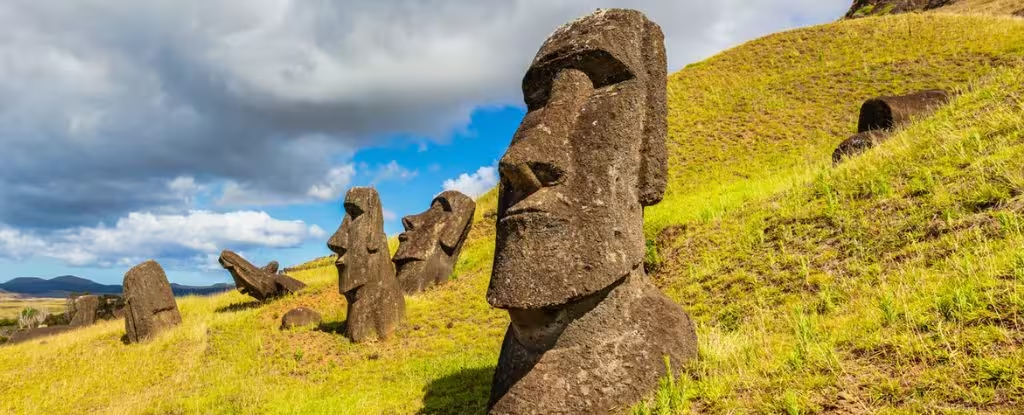“In just a few centuries, the people of Easter Island saw their forests destroyed, their plants and animals wiped out, and their complex society descended into chaos and cannibalism.” That’s what Jared Diamond wrote in his best-selling book Collapse It was published in 2005. Nearly two decades later, an international team of geneticists found evidence that this famous cautionary tale never happened.
As new discoveries show, the real story of Rapa Nui (called Easter Island by colonial Europeans) is not its own population decline, but its cultural resilience. It seems clear that the ancient inhabitants of Rapa Nui in the 1600s were not completely isolated on their island, and did not overexploit its resources to the point of “ecocide.”
Instead, ancient genetic evidence suggests that the island was once home to a small population of 1,500 to 3,000 people who interbred with populations of Polynesian and Native American ancestry long before Europeans reached either region.
Genetic analysis suggests that the Rapanui civilization actually thrived until the 1860s, when epidemics caused by slave raids in Peru and subsequent European colonial activity reduced the island’s population to about 110 people.
Today, more than 1,500 people living on Rapa Nui consider themselves Indigenous Rapanui.
“These results do not support a significant population decline after the initial settlement on Rapa Nui until the 1800s,” concluded the authors of the study, led by geneticists from the University of Copenhagen in Denmark and the University of Lausanne in Switzerland.
A wealth of archaeological and anthropological data already contradicts the Rapa Nui ecocide theory, but this new study is the first to use ancient genomic data to refute the history. The results are based on the remains of 15 ancient Rapa Nui people whose bones and teeth were excavated from the island by Europeans in the 19th and 20th centuries and preserved in several museums in Paris.
Following the museum’s strict guidelines, the researchers sequenced each individual’s genome, with support from the Commission for the Development of Rapa Nui (CODEIPA) and the Advisory Commission on National Monuments (CAMN). The team also held regular meetings with representatives of the Rapanui community. They hope their findings will inform the community’s efforts to bring their ancestors back to the island.
Based on a genomic analysis that reconstructed the Rapa Nui population over the last 100 generations, researchers say it is unlikely these people were born after contact with Europeans.
All 15 ancient Rapanui were found to be about 90 percent Polynesian. Their genes also contained about 10 percent Native American “mixture,” a hybridization that probably occurred between 1250 and 1430. Columbus did not reach the Americas until 1492, and European ancestry is found only in modern Rapanui, not ancient Rapanui.
The Rapanui and Polynesian populations today also contain a Native American component, which studies suggest was mixed into both gene pools between 1150 and 1495. This suggests that Polynesian sailors reached the Americas and Rapa Nui before Europeans. However, other studies of ancient Rapanui DNA have so far found no trace of Native American ancestry.
The lead authors of this latest study, geneticists J. Victor Moreno-Mayar, Anna-Sappo Malaspinas, and Barbara Sousa da Mota, told ScienceAlert that this is likely due to low data resolution and sampling errors. When the team reanalyzed ancient genomes from an earlier study, they found a Native American-like component in three of the five ancient Rapanui.
Meanwhile, another past study may have sequenced the genome of ancient Rapanui individuals. with This interbreeding occurred at or shortly after, before the evidence was incorporated into their genomes. The new findings “leave no doubt” that the ancient Rapanui interbred with Native Americans, evolutionary archaeogeneticists Stefan Schiffels and Kathryn Naegele write in an independent review of the study. Nature .
The question is how did the Rapanui come into contact with Native Americans, located in what Diamond once called “the most isolated inhabited area in the world,” some 1,800 km (1,100 mi) from the nearest inhabited island in Polynesia and 3,512 km (2,200 mi) from Chile in South America?
Experts have debated for years whether Pacific Islanders reached the Americas before Europeans. A 2020 genetic study found evidence of contact between Polynesians and Native American groups most closely related to the indigenous people of modern-day Colombia before the Rapa Nui settlement.
“While it is true that long-distance sea travel has declined over time, we know that Polynesians were truly skilled sailors who managed to reach every Polynesian island within 1,000 to 2,000 years,” Moreno-Mayar, Malaspinas and Mota explained to ScienceAlert.
“We think our results are likely to reach the Americas, as the sea was a path for them, not a barrier. So the evidence suggests that Rapa Nui was not that isolated, despite having thousands of people at one point separated by miles.” [його]other islands and America”. The study was published in: Nature.
Source: Port Altele
